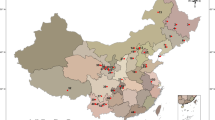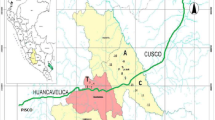Abstract
Canadian potato germplasm (Solanum tuberosum L.) is unique in its geographic and climatic ranges of adaptation, but little is known about the genetic diversity of the improved Solanum gene pool established over the past century. Simple sequence repeat (SSR) markers were applied to assess the genetic diversity of 114 Canadian and 55 exotic potato accessions. Thirty-six SSR primer pairs were applied and 232 polymorphic bands were scored for each accession. The frequencies of polymorphic bands ranged from 0.01 to 0.98 and averaged 0.35. The proportion of total SSR variation occurring between Canadian and exotic germplasm was 0.6%; among the Canadian cultivars of four major breeding periods 2.7%; among heirloom varieties, modern cultivars and elite breeding lines 4%; and between tetraploid and diploid lines 3.7%. Slightly more diversity was found for exotic, than the Canadian, germplasm. The modern cultivars displayed slightly more diversity than the heirloom varieties and the early cultivars revealed slightly more variation than the recent ones. Clustering 169 accessions revealed more than ten groups, but the groups were not distantly separated. Both the genetically most distinct accessions and the possible genetically duplicated accessions were identified. These findings not only demonstrate the narrow genetic base of the Canadian potato germplasm, but also are useful for managing the existing potato collection and for selecting genetically distinct potato materials to widen the genetic background of the potato gene pool.
Resumen
El germoplasma de de papa (Solanum tuberosum L.) canadiense es único en su adaptación geográfica y a variedad de climas, pero se conoce poco acerca de la diversidad genética del acervo genético mejorado de Solanum establecido durante el siglo pasado. Para evaluar la diversidad de 114 accesiones accesiones de papa canadiense y 55 foráneas se utilizaron marcadores de secuencia simple repetida (SSR). Se aplicaron 36 pares de iniciadores SSR y se evaluaron 232 bandas polimórficas para cada accesión. Las frecuencias de bandas polimórficas tuvieron un rango de 0.01 a 0.98 con un promedio de 0.35. La proporción de la variación total de SSR que ocurrió entre el germoplasma canadiense y foráneo fue de 0.6%; entre los cultivares canadienses de los cuatro principales periodos de mejoramiento 2.7%; entre las variedades ancestrales, los cultivares modernos, las líneas élite de mejoramiento 4%; y entre las líneas tetraploides y diploides 3.7%. Se ha encontrado una diversidad ligeramente mayor para el germoplasma foráneo que para el canadiense. Los cultivares modernos mostraron una diversidad ligeramente mayor que las variedades ancestrales y los cultivares antiguos revelaron una ligera mayor variación que los recientes. La agrupación de 169 accesiones reveló más de 10 grupos, pero éstos no estaban separados distantemente. Tanto las accesiones genéticamente más distintas como las posiblemente duplicadas fueron identificadas. Estos hallazgos no sólo demostraron la estrecha base genética del germoplasma canadiense de papa, sino que también son útiles para administrar la colección existente de papa, y para seleccionar materiales genéticamente distintos y ampliar la base genética del acervo genético de papa.


Similar content being viewed by others
References
Ames, M., and D.M. Spooner. 2008. DNA from herbarium specimens settles a controversy about origins of the European potato. American Journal of Botany 95: 252–257.
Anstey, T.H. 1986. One hundred harvests. Research Branch, Agriculture Canada, Historical Series No. 27.
Bornet, B., F. Goraguer, G. Joly, and M. Branchard. 2002. Genetic diversity in European and Argentinian cultivated potatoes (Solanum tuberosum subsp. Tuberosum) detected by inter-simple sequence repeats (ISSRs). Genome 45: 481–484.
Braun, A., and G. Wenzel. 2005. Molecular analysis of genetic variation in potato (Solanum tuberosum L.). I. German cultivars and advanced clones. Potato Research 47: 81–92.
de Jong, H., K.G. Proudfoot, and A.M. Murphy. 2001. The germplasm release of F87084, a fertile, adapted clone with multiple disease resistances. American Journal of Potato Research 78: 141–149.
de Jong, H., G.C.C. Tai, W.A. Russell, G.R. Johnston, and K.G. Proudfoot. 1981. Yield potential and genotype-environment interactions of tetraploid-diploid (4×−2×) potato hybrids. American Journal of Potato Research 58: 191–199.
del Rio, H., J.B. Bamberg, and Z. Huaman. 1997. Assessing changes in the genetic diversity of potato gene banks. 1. Effects of seed increase. Theoretical and Applied Genetics 95: 191–198.
Demeke, T., D.R. Lynch, L.M. Kawchuk, G.C. Kozub, and J.D. Armstrong. 1996. Genetic diversity of potato determined by random amplified polymorphic DNA analysis. Plant Cell Reports 15: 662–667.
Excoffier, L., P.E. Smouse, and J.M. Quattro. 1992. Analysis of molecular variance inferred from metric distances among DNA haplotypes: Application to human mitochondrial DNA restriction data. Genetics 131: 479–491.
Excoffier, L., G. Laval, and S. Schneider. 2005. Arlequin ver. 3.0: An integrated software package for population genetics data analysis. Evolutionary Bioinformatics Online 1: 47–50.
Feingold, S., J. Lloyd, N. Norero, M. Bonierbale, and J. Lorenzen. 2005. Map** and characterization of new EST-derived microsatellites for potato (Solanum tuberosum L.). Theoretical and Applied Genetics 111: 456–466.
Fu, Y.B. 2006. Genetic redundancy and distinctness of flax germplasm as revealed by RAPD dissimilarity. Plant Genetic Resources 4: 117–124.
Ghislain, M., D.M. Spooner, F. Rodriguez, F. Villamon, J. Nunez, C. Vasquez, R. Waugh, and M. Bonierbale. 2004. Selection of highly informative and user-friendly microsatellites (SSRs) for genoty** of cultivated potato. Theoretical and Applied Genetics 108: 881–890.
Ghislain, M., D. Andrade, F. Rodríguez, R.J. Hijmans, and D.M. Spooner. 2006. Genetic analysis of the cultivated potato Solanum tuberosum L. Phureja Group using RAPDs and nuclear SSRs. Theoretical and Applied Genetics 113: 1515–1527.
Guenthner, J. 2001. The International Potato Industry. Cambridge: Woodhead.
Hawkes, J.G. 1978. Genetic poverty of the potato in Europe. In Broadening the Genetic Base of Crops, eds. A.C. Zeven, and A.M. van Harten, 19–27. The Netherlands: Pudoc, Wageningen.
Hosaka, K., M. Mori, and K. Ogawa. 1994. Genetic relationships of Japanese potato cultivars assayed by RAPD analysis. American Journal of Potato Research 71: 535–546.
Ispizúa, V.N., I.R. Guma, S. Feingold, and A.M. Clausen. 2007. Genetic diversity of potato landraces from northwestern Argentina assessed with simple sequence repeats (SSRs). Genetic Resources and Crop Evolution 54: 1833–1848.
Karp, A. 2002. The new genetic era: will it help us in managing genetic diversity? In Managing Plant Genetic diversity, eds. J.M.M. Engels, V.R. Rao, A.H.D. Brown, and M.T. Jackson, 43–56. Rome: International Plant Genetic Resources Institute.
Kim, J.H., H. Joung, H.Y. Kim, and Y.P. Lim. 1998. Estimation of genetic variation and relationship in potato (Solanum tuberosum L.) cultivars using AFLP markers. American Journal of Potato Research 75: 107–112.
Kumar, S., K. Tamura, and M. Nei. 2004. MEGA3: Integrated software for molecular evolutionary genetics analysis and sequence alignment. Briefings in Bioinformatics 5: 150–163.
Loiselle, F., G.C.C. Tai, T.R. Tarn, and B.R. Christie. 1989a. The use of multivariate analyses to elimiate redunant variables when evaluating potatoes for chip quality. Plant Breeding 103: 153–162.
Loiselle, F., G.C.C. Tai, B.R. Christie, and T.R. Tarn. 1989b. Relationship between inbreeding coefficient and clonal selection in a potato cultivar development program. American Journal of Potato Research 66: 747–753.
Love, S.L. 1999. Founding clones, major contributing ancestors, and exotic progenitors of prominent North American potato cultivars. American Journal of Potato Research 76: 263–272.
Lynch, D.R., Q. Chen, L.M. Kawchuk, and D. Drieger. 2004. Verticillium wilt resistant germplasm-release of clone LRC18-21 and derivatives. American Journal of Potato Research 81: 295–297.
Mendoza, H.A., and F.L. Haynes. 1974. Genetic relationship among potato cultivars grown in the United States. HortScience 9: 328–330.
Milbourne, D., R. Meyer, J.E. Bradshaw, E. Baird, N. Bonar, J. Provan, W. Powell, and R. Waugh. 1997. Comparison of PCR-based marker systems for the analysis of genetic relationships in cultivated potato. Molecular Breeding 3: 127–136.
Milbourne, D., R.C. Meyer, A.J. Collins, L.D. Ramsay, C. Gehbardt, and R. Waugh. 1998. Isolation, characterization and map** of simple sequence repeat loci in potato. Molecular and General Genetics 259: 233–245.
Ortiz, R., and Z. Huaman. 2001. Allozyme polymorphisms in tetraploid potato gene pools and the effect on human selection. Theoretical and Applied Genetics 103: 792–796.
Plaisted, R.L., and R.W. Hoopes. 1989. The past record and future prospects for the use of exotic potato germplasm. American Journal of Potato Research 66: 603–627.
Powell, W., M.S. Phillips, J.W. McNicol, and R. Waugh. 1991. The use of DNA markers to estimate the extent and nature of genetic variability in Solanum tuberosum cultivars. Annals of Applied Biology 118: 423–432.
Rohlf, F.J. 1997. NTSYS-PC 2.1. Numerical taxonomy and multivariate analysis system. Setauket: Exeter Software.
Ross, H. 1986. Potato breeding—Problems and perspectives. Berlin Hamburg: Verlag Paul Parey.
Roussel, V., J. Koenig, M. Bechert, and F. Balfourier. 2004. Molecular diversity in French bread wheat accessions related to temporal trends and breeding programmes. Theoretical and Applied Genetics 108: 920–930.
SAS Institute Inc. 2004. The SAS system for windows V8.02. Cary: SAS Institute Incorporated.
Simko, I., K.G. Haynes, and R.W. Jones. 2004. Mining data from potato pedigrees: tracking the origin of susceptibility and resistance to Verticillium dahliae in North American cultivars through molecular marker analysis. Theoretical and Applied Genetics 108: 225–230.
Simko, I., K.G. Haynes, and R.W. Jones. 2006. Assessment of linkage disequilibrium in potato genome with single nucleotide polymorphism markers. Genetics 173: 2237–2245.
Sokal, R.R., and C.D. Michener. 1958. A statistical method for evaluating systematic relationships. University of Kansas Science Bulletin 38: 1409–1438.
Spooner, D.M., and A. Salas. 2006. Structure, biosystematics and genetic resources. In Handbook of potato production, improvement, and postharvest management, eds. J. Gopal, and S.M.P. Khurana, 1–39. Binghamton: Food Products.
Swofford, D.L. 1998. PAUP*. Phylogenetic Analysis Using Parsimony (*and Other Methods). Version 4. Sunderland: Sinauer Associates.
Tarn, T.R., and G.C.C. Tai. 1983. Tuberosum x Tuberosum and Tuberosum x Andigena potato hybrids: comparisons of families and parents, and breeding strategies for Andigena potatoes in long-day temperate environments. Theoretical and Applied Genetics 66: 87–91.
Tarn, T.R., G.C.C. Tai, H. de Jong, A.M. Murphy, and J.E.A. Seabrook. 1992. Breeding potato for long-day, temperate climates. Plant Breeding Reviews 9: 217–232.
Turner, S., and H. Molyneaux. 2004. Agricultural science, potato breeding, and the Fredericton Experimental Station, 1912–1966. Acadiensis 33: 1–25.
Wang, D., J. Shi, S. Carlson, P.B. Cregan, R. Ward, and B. Diers. 2003. A low-cost, high-throughput polyacrylamide gel electrophoresis system for genoty** with microsatellite DNA markers. Crop Science 43: 1828–1832.
Acknowledgments
The authors would like to thank Garrett Pittenger and Seeds of Diversity Canada for assistance in acquiring heirloom varieties; Joyce and Robert Coffin (Privar Farm, North Wiltshire, PE), Pierre Turcotte (Les Buissons Research Centre, Quebec Department of Agriculture, Fisheries and Food, QC), Kirby Sawatzky (Parkland Seed Potatoes Ltd, Lacombe, AB), and Benoit Bizimungu (Lethbridge Research Centre, AAFC, Lethbridge, AB) for providing the Canadian cultivars not in the repository; colleagues in the AAFC potato breeding program at Fredericton for providing additional germplasm and cultivars; Marcie Heggie and Susan MacWilliam for their technical support; and three anonymous reviewers for helpful comments on the early version of the manuscript.
Author information
Authors and Affiliations
Corresponding author
Rights and permissions
About this article
Cite this article
Fu, YB., Peterson, G.W., Richards, K.W. et al. Genetic Diversity of Canadian and Exotic Potato Germplasm Revealed by Simple Sequence Repeat Markers. Am. J. Pot Res 86, 38–48 (2009). https://doi.org/10.1007/s12230-008-9059-6
Received:
Accepted:
Published:
Issue Date:
DOI: https://doi.org/10.1007/s12230-008-9059-6




